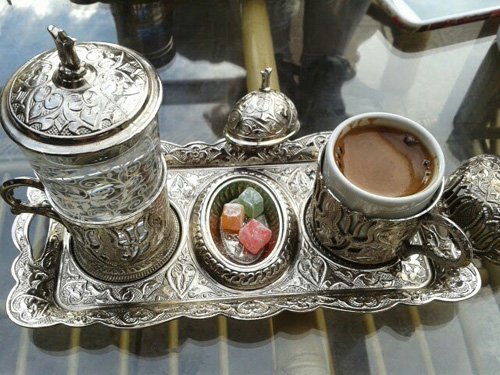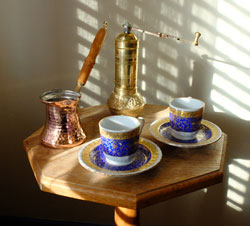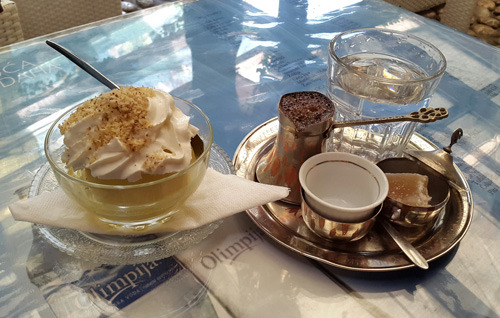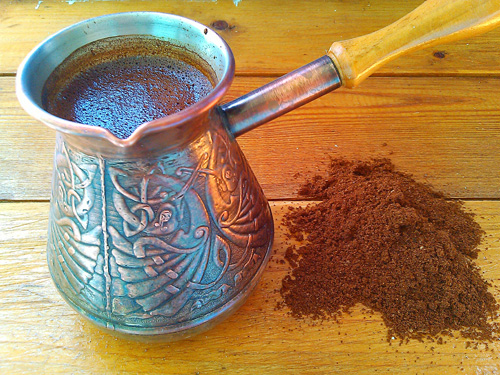How to make Turkish coffee – and break all the rules of modern coffee brewing.
Strictly speaking, “Turkish coffee” was first made in Egypt. But by the 16th century, both coffee and this particular coffee-making method were firmly rooted in Turkey.
Even today, coffee is still made this way...in Turkey, much of the Middle East and the Balkans.
How Turkish coffee breaks the rules...
This makes us smile, a lot. There is a certain snobbery among some gourmet coffee drinkers. So it with great pleasure and irony that one brews and serves up a small demitasse of Turkish coffee, knowing that the brewing method flies in the face of what experts today advise.
First, the coffee grounds and water are boiled together.
Second, you add sugar during the brewing process, not after the coffee is poured.
Third, no filter is used. So you end up with plenty of coffee grounds in your cup.
Milk or cream? Absolutely not.
Turkish coffee may be sweetened, but it is served black, with a natural froth on the surface.
How to make Turkish coffee...
The only equipment you need is an ibrik or “cezve”, which is a brass pot with a long handle.
As for the coffee grounds, they need to be very, very finely ground, to the consistency of talcum powder. If you have a burr grinder that will grind that fine, so much the better. Otherwise you may have to buy ground coffee specifically intended for making Turkish coffee.
Here’s what you do:
- Add one demitasse of water and one heaped teaspoon of ground coffee to the ibrik for each serving.
- Add sugar. Again, one teaspoon per demitasse. You can vary that a little according to your own preferences.
- Then place the ibrik on the stove or over a flame with a low heat, and stir it while it heats up...slowly.
- When the coffee boils and froths up, remove it from the heat, spoon a little of the froth into each cup, and then return the ibrik to stove or burner.
- When the coffee froths up a second time, pour the coffee into the cups, with the remaining froth.
- Once in the cups the coffee should not be stirred again.
- Sip gently, as there will be plenty of coffee grounds in the cup, and while you will inevitably drink some of them, you want to leave most at the bottom of the cup.
And there you have it, a perfect cup of Turkish coffee, made in the simplest manner possible, and breaking all the rules.
If this sounds different from instructions you may have read elsewhere, that's because Turkish coffee is made in many different regions and countries, and each has its own way of brewing what they consider to be the perfect cup.
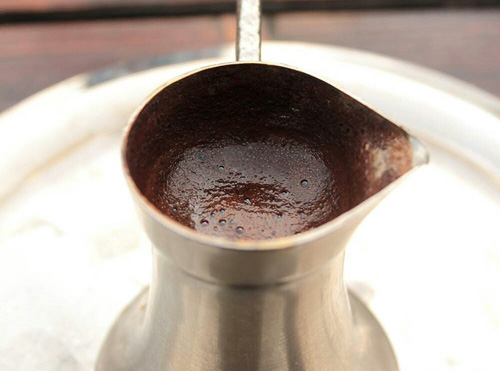 There are local variations on Turkish coffee served in other countries. This Bosanska kafa was brewed in Croatia.
There are local variations on Turkish coffee served in other countries. This Bosanska kafa was brewed in Croatia.How does Turkish coffee taste? It tastes great.
I know, because many moons ago I lived in Turkey for a year and drank Turkish coffee every day. It has its own unique taste, and is nothing like your usual cup of morning joe. It is thick, sweet and very much a sipping coffee.
Do you get coffee grinds in your mouth? Yes, you do. But they are so finely ground it’s nothing like even getting espresso grinds in your mouth. There is nothing hard there. More like a soft, smooth paste.
If you have never tried Turkish coffee before, I can certainly recommend it.
About the author: Nick Usborne, aka Coffee Detective, is a writer and long-time coffee enthusiast. Read more…
Before you go, sign up to receive the Coffee Detective Newsletter...
Sign up for occasional newsletters about the best coffees and brewing equipment. Plus special updates from the Coffee Detective Coffee Store…
